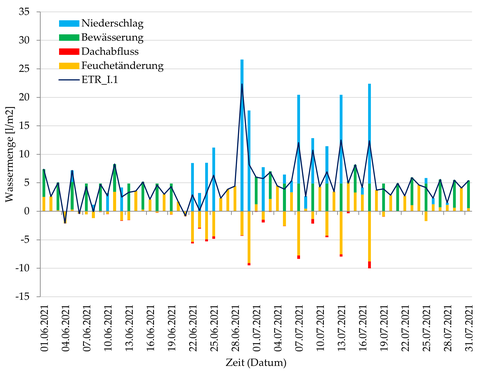Master Thesis Mustafa Altattan
Application of the airflow-network model for selected test cases in EnergyPlus and evaluation of its input parameter sensitivity via parametric runs
Anwendung des Airflow-Network-Modells für ausgewählte Testfälle in EnergyPlus und Ermittlung der Eingangskennwerte-Sensitivität and Hand von Parameterstudien

Evapotranspirationsbilanz im Feld 1
Especially in historical buildings, which show a lower air-tightness compared to new buildings, ventilation heat losses make up a major part of the overall energy demand of the buildings. A sound definition of air exchange rates (infiltration air exchange) resulting from wind-driven pressure conditions is required for realistic estimation of ventilation-related energy demand. One approach for this estimation is the airflow network model, which goes back to the AIRNET program developed by G. N. Walton. It allows a computation of multizone pressure conditions in a building resulting from wind conditions and duct system conditions. The latter is not a subject of this work.
The project work aims to give an overview of the model itself including its restrictions and assumptions (e.g. constant air volume) for natural airflow (infiltration and window ventilation). It starts with an explanation of the calculation procedure (calculation of pressure at the defined nodes and airflow through the defined linkages, node temperature and humidity calculation, in case of HVAC-systems: sensible and latent load calculations: not considered in this work).
Furthermore, all input objects and corresponding settings in case of natural ventilation regarding building envelope properties (e.g. reference crack conditions, surface crack data resp. detailed opening), internal building constellation (e.g. component leakage ratio, component leak) and boundary conditions (e.g. site wind conditions, wind pressure coefficient values, wind pressure coefficient array) are explained.
Based on these settings, guiding parameters are selected for parametric runs for the example of a historic building. This assumes a basic model, set up by the help of Design Builder and initially checked (verification, validation). This model is to be exported as IDF and modified via IDF-Editor. Leading parameters are then varied in order to point out the sensitivity of the model for the selected parameters. The results of this analysis are illustrated in graphs and interpreted.
Download
Master Thesis Mustafa Altattan (pdf)
Supervisor
P. Freudenberg (main supervisor), H. Fechner (supporting supervisor)
 © Dr. Ing. Peggy Freudenberg
© Dr. Ing. Peggy Freudenberg
Chair Representative
NameDr.-Ing. Peggy Freudenberg
Send encrypted email via the SecureMail portal (for TUD external users only).
